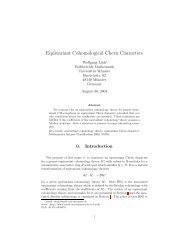Connes-Chern Character for Manifolds with Boundary and ETA ...
Connes-Chern Character for Manifolds with Boundary and ETA ...
Connes-Chern Character for Manifolds with Boundary and ETA ...
Create successful ePaper yourself
Turn your PDF publications into a flip-book with our unique Google optimized e-Paper software.
CONNES-CHERN CHARACTER AND <strong>ETA</strong> COCHAINS 71<br />
<strong>with</strong> ˆ⊗ denoting the completed bornological tensor product. The b-volume <strong>for</strong>m µ b<br />
associated to g b gives rise to an embedding<br />
M ∞( ∂M, M; E ′ ⊗ F ) ↩→ J ∞( ∂(M × M), M × M; E ⊠ F ′) ′<br />
,<br />
( ∫<br />
k ↦→ u ⊗ v ↦→ 〈k(p, q), u(p) ⊗ v(q)〉 d ( )<br />
)<br />
µ b ⊗ µ b (p, q) ,<br />
M×M<br />
(A.14)<br />
which we use implicitly throughout this work. In the <strong>for</strong>mula <strong>for</strong> the embedding,<br />
〈−, −〉 denotes the natural pairing of an element of a vector bundle <strong>with</strong> an element<br />
of the dual bundle over the same base point, u, v are elements of J ∞( ∂M, M; E ) <strong>and</strong><br />
J ∞( ∂M, M; F ′) respectively, <strong>and</strong> M ∞( X, M; E) denotes <strong>for</strong> X ⊂ M closed the space<br />
of all sections u ∈ Γ ∞ (M \ X; E) such that in local coordinates (y, η) : π −1<br />
E (U) →<br />
R dim M+dim E <strong>with</strong> U ⊂ M open one has <strong>for</strong> every compact K ⊂ U, p ∈ K \ X, <strong>and</strong><br />
α ∈ N dim M an estimate of the <strong>for</strong>m<br />
∥ ∂<br />
α<br />
y<br />
(<br />
η ◦ u<br />
)<br />
(p)<br />
∥ ∥ ≤ C<br />
1<br />
(d ( y(p), y(X ∩ U) )) λ ,<br />
where C > 0 <strong>and</strong> λ > 0 depend only on the local coordinate system, K, <strong>and</strong> α. The<br />
fundamental property of M ∞( X, M; E) is that<br />
J ∞ (X, M) · M ∞( X, M; E) ⊂ J ∞ (X, M; E).<br />
Note that the vector bundle E (<strong>and</strong> likewise the vector bundle F ) gives rise to a<br />
pull-back vector bundle pr ∗ ∂M E |∂M on the cylinder, where pr ∂M : R × ∂M → ∂M is<br />
the canonical projection. This pull-back vector bundle will be denoted by E (resp. F ),<br />
too. As further preparation we introduce two auxiliary functions ψ : M → [0, 1] <strong>and</strong><br />
ϕ : M → [0, 1] on M which are smooth <strong>and</strong> satisfy supp ψ ⊂⊂ M 1 , ψ(p) = 1 <strong>for</strong><br />
p ∈ M 3/2 , supp ϕ ⊂⊂ Y 1 , <strong>and</strong> finally ϕ(p) = 1 <strong>for</strong> p ∈ Y 1/2 . Such a pair of functions<br />
will be called a pair of auxiliary cut-off functions.<br />
By a b-pseudodifferential operator of order m ∈ R we now underst<strong>and</strong> a continuous<br />
operator A : J ∞ (∂M, M; E) → J ∞ (∂M, M; F ) ′ such that <strong>for</strong> one (<strong>and</strong> hence <strong>for</strong> all)<br />
pair(s) of auxiliary cut-off functions the following is satisfied:<br />
( b Ψ1) The operator (1 − ϕ)A(1 − ϕ) is a compactly supported pseudodifferential operator<br />
of order m in the interior M ◦ .<br />
( b Ψ2) The operator ϕAψ is smoothing. Its integral kernel K ϕAψ has support in<br />
supp ϕ × M <strong>and</strong> lies in J ∞( ∂(M × M), M × M; E ′ ⊠ F ) .<br />
( b Ψ3) The operator ψAϕ is smoothing. Its integral kernel K ψAϕ has support in M ×<br />
supp ϕ <strong>and</strong> lies in J ∞( ∂(M × M), M × M; E ′ ⊠ F ) .<br />
( b Ψ4) Consider the induced operator on the cylinder<br />
à : b S ( R × ∂M; E ) → b S ( R × ∂M; F ) ′<br />
,<br />
(<br />
u ↦→ (t, p) ↦→ [ (1 − ψ)A(1 − ψ) ( (x, η) ∗ u )]( (x, η) −1 (t, p) )) ,<br />
where b S ( R × ∂M; E ) := b S (R) ˆ⊗C ∞( ∂M; E ) . Denote by ã := σ(Ã) ∈<br />
S m( T ∗ (R×∂M); π ∗ Hom(E, F ) ) the complete symbol of à defined by Eq. (A.12)

















